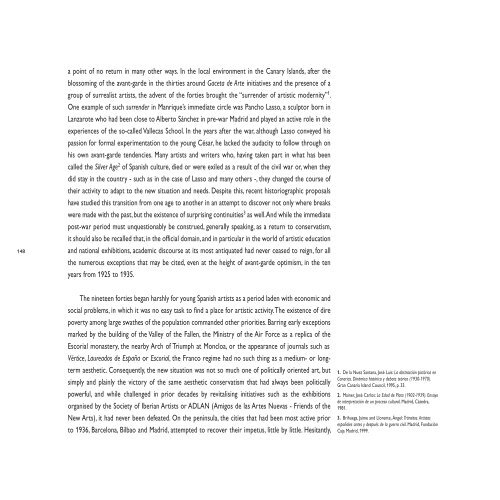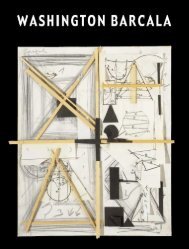VERSIÓN INGLESA ENGLISH VERSION - Fundación César Manrique
VERSIÓN INGLESA ENGLISH VERSION - Fundación César Manrique
VERSIÓN INGLESA ENGLISH VERSION - Fundación César Manrique
Create successful ePaper yourself
Turn your PDF publications into a flip-book with our unique Google optimized e-Paper software.
148<br />
a point of no return in many other ways. In the local environment in the Canary Islands, after the<br />
blossoming of the avant-garde in the thirties around Gaceta de Arte initiatives and the presence of a<br />
group of surrealist artists, the advent of the forties brought the “surrender of artistic modernity” 1 .<br />
One example of such surrender in <strong>Manrique</strong>’s immediate circle was Pancho Lasso, a sculptor born in<br />
Lanzarote who had been close to Alberto Sánchez in pre-war Madrid and played an active role in the<br />
experiences of the so-called Vallecas School. In the years after the war, although Lasso conveyed his<br />
passion for formal experimentation to the young <strong>César</strong>, he lacked the audacity to follow through on<br />
his own avant-garde tendencies. Many artists and writers who, having taken part in what has been<br />
called the Silver Age 2 of Spanish culture, died or were exiled as a result of the civil war or, when they<br />
did stay in the country - such as in the case of Lasso and many others -, they changed the course of<br />
their activity to adapt to the new situation and needs. Despite this, recent historiographic proposals<br />
have studied this transition from one age to another in an attempt to discover not only where breaks<br />
were made with the past, but the existence of surprising continuities 3 as well. And while the immediate<br />
post-war period must unquestionably be construed, generally speaking, as a return to conservatism,<br />
it should also be recalled that, in the official domain, and in particular in the world of artistic education<br />
and national exhibitions, academic discourse at its most antiquated had never ceased to reign, for all<br />
the numerous exceptions that may be cited, even at the height of avant-garde optimism, in the ten<br />
years from 1925 to 1935.<br />
The nineteen forties began harshly for young Spanish artists as a period laden with economic and<br />
social problems, in which it was no easy task to find a place for artistic activity. The existence of dire<br />
poverty among large swathes of the population commanded other priorities. Barring early exceptions<br />
marked by the building of the Valley of the Fallen, the Ministry of the Air Force as a replica of the<br />
Escorial monastery, the nearby Arch of Triumph at Moncloa, or the appearance of journals such as<br />
Vértice, Laureados de España or Escorial, the Franco regime had no such thing as a medium- or longterm<br />
aesthetic. Consequently, the new situation was not so much one of politically oriented art, but<br />
simply and plainly the victory of the same aesthetic conservatism that had always been politically<br />
powerful, and while challenged in prior decades by revitalising initiatives such as the exhibitions<br />
organised by the Society of Iberian Artists or ADLAN (Amigos de las Artes Nuevas - Friends of the<br />
New Arts), it had never been defeated. On the peninsula, the cities that had been most active prior<br />
to 1936, Barcelona, Bilbao and Madrid, attempted to recover their impetus, little by little. Hesitantly,<br />
1. De la Nuez Santana, José Luis: La abstracción pictórica en<br />
Canarias. Dinámica histórica y debate teórico (1930-1970).<br />
Gran Canaria Island Council, 1995, p. 33.<br />
2. Mainer, José Carlos: La Edad de Plata (1902-1939). Ensayo<br />
de interpretación de un proceso cultural. Madrid, Cátedra,<br />
1981.<br />
3. Brihuega, Jaime and Llorente, Ángel: Tránsitos. Artistas<br />
españoles antes y después de la guerra civil. Madrid, <strong>Fundación</strong><br />
Caja Madrid, 1999.
















![Becas y premios de la Fundación César Manrique [1997-2006]](https://img.yumpu.com/20766851/1/184x260/becas-y-premios-de-la-fundacion-cesar-manrique-1997-2006.jpg?quality=85)
